A holiday in West Wales in the early Autumn of 2022 led to a little research on the railways in the area.
This is the fourth article about Pembrokeshire’s Railways. The first focussed on the pre-railway age, the second focussed on the mainline railways of the county. The third article focussed on the industrial railways in the vicinity of Milford Haven. The links to these three posts are provided below. This article looks specifically at the Saundersfoot Railway in Pembrokeshire.
Railways in West Wales Part 1A – Pembrokeshire – Before the Railway Age
Railways in West Wales Part 1B – Pembrokeshire – the Mainline Railways
https://rogerfarnworth.com/2022/09/20/__trashed-3/
Industrial Railways
The industrial railways of Pembrokeshire include:
- The Saundersfoot Railway (covered in this article and a follow-up article).
- The Milford Haven Docks Railways (covered in a previous article).
- The Milford & St. Bride’s Bay Light Railway and proposals for expansion of the Docks at Milford Haven (covered in a previous article).
- The Royal Navy Armaments Depot at Newton Noyes (RNMD Milford Haven) (covered in a previous article).
- The Royal Navy Armaments Depot at Trecwn (RNAD Trecwn) (covered in a future article).
- Milford Haven Oil Refineries (covered in a previous article).
- The Freystrop Colliery Railway (covered in a previous article).
- The Hook Colliery Railway (covered in a previous article).
The Saundersfoot Railway
“Saundersfoot began life as a few medieval cottages in a forest clearing in Coedrath, a hunting ground of the Norman Earls of Pembroke. Five hundred years later it had grown into thriving coal port with its abundance of anthracite coal, and exported 30,000 tons annually from its harbour.” 150 years on when the coal industry vanished Saundersfoot evolved into a seaside resort. [132]
“‘Saundersfoote’ was first referred to by the Elizabethan Historian George Owen when describing the coal measures of Pembrokeshire, however on county maps from the 16th century it was referred to the village as St. Issells, the name of the parish. A water course paid rent for by Walter Elisaunder in 1332, Elisaunder’s Ford may originally have given the hamlet its name, being shortened to Saundersford.” [132]
Wikipedia tells us that the Saundersfoot Railway was an industrial narrow-gauge railway in Pembrokeshire, Wales, built between 1830–1834, to connect Saundersfoot harbour to the local coal mines. Trading began on 1st March 1834 and within a few years it comprised a small network of over 4 miles (6.4 km) along the coast from Saundersfoot to Wisemans Bridge and on to the collieries at Stepaside and Kilgetty, and later, running inland to Thomas Chapel near Begelly. [1: p131][49]
The Saundersfoot Railway provides the first example in Pembrokeshire of the joint construction of a harbour and tramway, and remained independent until it closed in 1939.[1: p128][49] The first image below comes from the very early 19th century and shows Saundersfoot before the construction of the harbour and railway. …


I guess that it is appropriate to ask whether it is a tramway/tramroad or a railway. I have chosen to treat it as a ‘railway’ because of its longevity, it’s own claim to be a ‘railway’ and because, ultimately it’s tracks were re-laid with flat bottom edge-rails on wooden sleepers which made it as much of a railway as any other line. Indeed Connop-Price says that “the Saundersfoot Railway and Harbour Company was an important undertaking in the context of Pembrokeshire. As it developed it metamorphosed from early tramroad to true railway (my emphasis), and by so doing was, in transport terms, a pivotal enterprise.Futhermore it was the earliest example in Pembrokeshire of an idea pioneered in South Wales – the planning of a railway and harbour as a single combined undertaking.” [1: p128]
High quality anthracite was found in the Saundersfoot area which was part of what became known as the Pembrokeshire Coalfield. The likely quantities involved were large and it quickly became essential to create a tramroad to move the extracted coal to the coast for onward shipping. “The Saundersfoot Railway and Harbour Company was formed in 1828 to build a harbour at Saundersfoot and a tramway to connect it to the collieries around Begelly and Stepaside. In 1829, Parliamentary authorisation was given for the Saundersfoot Railway and Harbour Company. This was to be a four-feet gauge horse operated tramroad, connecting collieries with a new harbour at Saundersfoot.” [49]

The Act authorised a length of tramroad from the new harbour to pits in the hamlet of Thomas Chapel, Northwest of Begelly – close to 5 miles inland. “Two branches were also approved – the first from Ridgeway near Saundersfoot due West to Morton, … a distance of about a mile, and the second running North along the coast from the harbour to Wiseman’s bridge.” [1: p128 &131]
It is interesting to note that prior to the coming of the tramroad through Wiseman’s Bridge to Stepaside and Kilgetty a canal, the Kilgetty Canal, was built about 1792 to link collieries in Kilgetty/Stepaside to Wiseman’s Bridge, where high quality anthracite was carted onto beached schooners for dispatch to UK and European customers. The canal was only 10’-12’ wide and without locks, only tub boats would have operated along it. Being poorly designed, the canal was not successful and a horse-drawn tramway to Wiseman’s Bridge replaced it. Little remains of the canal today, except for the canal basin and the sluice at Wiseman’s Bridge, which controlled the level of water in the canal. [144]
Coflein tells us that “the harbour was built in 1829-30 … for the exportation of anthracite. By 1837, the harbour had five jetties handling coal, iron ore, pig iron and firebricks from local companies and mines. In 1884, Sailing Directions noted that the southern pier … ‘has a spur for checking the in-run of the sea, the entrance faces east, and is 35 yards wide; off which is a warping buoy. The bottom on the west side of the harbour is hard, but the rest consists of mud and sand, with a shelving beach in the northeast corner. At the south pier end, a yellow ball is hoisted while there is a depth of 8 feet water within the entrance; at night a red light is shown during the same time, which is elevated 15 feet above the highwater. Vessels of 16 feet draught can enter the harbour on spring tides, and those of 9 feet on neaps; two qualified pilots attend every tide, and whose charge is by agreement. In entering, it is necesssary to luff short round the south pier head and check the vessel’s way in time?’ Those Directions also note: ‘Tramroads connect the western side of the harbour with the collieries, which are situated about 3 miles within.’ [133]
Coflein comments: “The Saundersfoot railway was built to link Bonville Court mine and others to the Stepaside Ironworks (NPRN 43501, 43052).” [133] It seems, however, that Boneville Court Colliery and the Ironworks were built a little later than some of the other collieries opened, [134] so it seems fairer to say that a component of traffic on the line was generated by the existence of the Stepaside Ironworks until its closure in the mid- to late-1870s.
In its original form the Saundersfoot Railway was an edge-railway but it was like a tramroad in that the Company provided a transport facility for which it charged tolls to users of the line. Connop-Price says that “such a line was an entirely logical development from the era of canals and turnpike trusts, but it was only adequate when traffic was not continuous, and haulage was by horse or oxen.” [1: p131] As we have already noted, the original cast Iron rails supported on stone-blocks had to be replaced and the line developed into a railway, albeit of 4ft gauge (perhaps 0.75in wider?), rather than standard-gauge and, as we will see, a very reduced headroom.


The authoritative text is ‘The Saundersfoot Railway’ written by M.R. Connop-Price which is No. 28 in the Oakwood Press series of Locomotion Papers. [136] Oakwood Press is now owned by Stenlake Publishing but existed independently from its founding in 1931 until 2016. The early editions of this book were all published from Usk in Monmouthshire. Connop-Price has also written ‘Pembrokeshire: the Forgotten Coalfield, publihed in 2004 by Landmark Publishing, Ashbourne Derbyshire which contains a significant chapter on Mining Transport. [1: p120-144]
The Saundersfoot Railway had two main mineral lines which were fed by a number of branches. Horse-power was used at first with horses pulling up to three laden trams (wagons). Wikipedia tells us that the two main lines were:
- A line connecting the collieries and the later ironworks close to Stepaside which ran along the coast to the harbour in Saundersfoot. [32][49]
- A line from Thomas Chapel colliery near Begelly to the harbour in Saundersfoot. This line passed beneath the GWR station in a tunnel at King’s Moor and had an incline around half-a-mile from the harbour which had a gradient of 1 in 5. [49]
This, while true, somewhat simplifies the development of the line. We noted above that the 1829 Act authorised two branches, one of which was the nascent form of first line mentioned immediately above, although it limited the line running North to a terminus at Wiseman’s bridge until the harbour was operational at Saundersfoot. [1: p131]
The mainline running towards Begelly and Thomas Chapel was substantially complete between Begelly and the harbour by the time the Company officially began trading on 1st March 1834. The branch to Moreton, however, was not constructed immediately. The line to Wiseman’s Brdige was substantially complete by June 1834. Connop-Price tells us that the line suffered a number of rock falls and, as a result, broken rails and it seems highly unlikely that the line saw any significant use. [1: p131]
Both the branch along the coast and the harbour suffered storm damage. An extension to the North pier of the harbour narrowed the harbour entrance and gave much greater protection to vessels within. [1: p131]
It was decided to realign the tramroad to Wiseman’s Bridge and, when another Act of Parliament was needed to renew powers to build the Moreton branch (1842), the realignment of the coastal line was included as well as an extension to Lower Level Colliery at Kilgetty. “The line to Wiseman’s Bridge was rebuilt on a slightly altered alignment, and at a slightly higher level beneath the cliffs North of Coppet Hall; the extension to Kilgetty gradually steepened over its final mile until it reached a gradient of 1 in 32 on the approaches to Lower Level Colliery.” [1: p132] That 1842 Act also authorised another branch from Kingsmoor to Broadmoor and Masterlands, although a decision not to contract that line was made before the middle of the 1840s. {1: p132]
On the line West from the harbour after about a half-mile journey there was a self-acting incline which worked well for those exporting goods from the harbour bringing it down the line. The loaded trams lifting the empty trams up the incline. It did not work well for those importing freight such as pit-props or stone. Eventually a winch was provided so as to avoid damage to the land alongside the incline. [1: p132]
On learning of the South Wales Railway’s plan to build a branch from its mainline to Pembroke, the Saundersfoot Railway’s board of directors decided to construct a line to meet the GWR at Reynalton. Their scheme was authorised in 1846. However, the South Wales Railway failed to provide the branch to Pembroke. The Saundersfoot Railway’s proposed Tenby, Saundersfoot & South Wales Railway and Pier Company line was not built. [49] Another Company built a standard-gauge line between Pembroke and Tenby -The Pembroke and Tenby Railway (in 1863), and then extended that line to meet the South Wales Railway at Whitland. (in around 1865). Moreton Colliery got its own siding on that line but Boneville Court Colliery did not. Coal drops were provided at the point where the Saundersfoot Railway passed under the standard-gauge line. [1: p133] Eventually Saundersfoot Station was built at this site.
As part of a modernisation project, the whole line was upgraded to a narrow gauge railway in 1874. The tramway along the coast was re-laid with flat bottom rails on wooden sleepers allowing a locomotive to be used on the line to Stepaside. [49]
In April 1874 an 0-4-0ST built by Manning Wardle of Leeds (Rosalind) was purchased and worked the line between the harbour and Lower Level Colliery. “Horses were retained to work the portion of the line from the harbour to the incline, and also from the top of the incline to to the exchange siding at Saundersfoot Station. The failure of collieries at Thomas Chapel, and the decline in mining at Begelly, meant that by this date traffic worked through Kingsmoor Tunnel was negligible.”[1: p133]
The track north of the standard-gauge line was lifted in 1887, however, in 1914 it was re-laid and a new 1.5 mile branch line built to support the opening of a short-lived colliery at Reynalton. A new engine was purchased for this purpose. [49]
In 1889/1890 the track between the harbour and the incline was re-laid to allow it to be worked by Rosalind. In 1893, Bonevilles Court colliery was provided a siding from the standard-gauge line and the exchange sidings at Saundersfoot Station fell into disuse as did the line between the incline and the station. By this time harbour traffic was limited to coal and culm from two collieries, Bonevilles Court and Lower Level. [1: p133]
By the late 1920s coal mining was in recession and the line closed. In 1932 a brief resurgence in local mining led to the lines being briefly reopened. [49]
However, only seven years later, due to financial considerations and the workings becoming exhausted, the railway finally closed on the eve of the Second World War. Subsequently, the rolling stock along with the tracks were scrapped for use in the war effort. [49]
Locomotives – Both engines used on the line had low profiles so they could work the tunnels. Although Rosalind was scrapped, Bulldog continued to work at Llanelli steel works until 1951. [49]
| Name | Builder | Wheel arrangement | Date | Works number | Notes |
|---|---|---|---|---|---|
| Rosalind | Manning Wardle | 0-4-0ST | 1874 | 476 | |
| Bulldog | Kerr Stuart | 0-4-0ST | 1915 | 2040 | Purchased from the New Reynalton Anthracite Coal Company in 1921 |


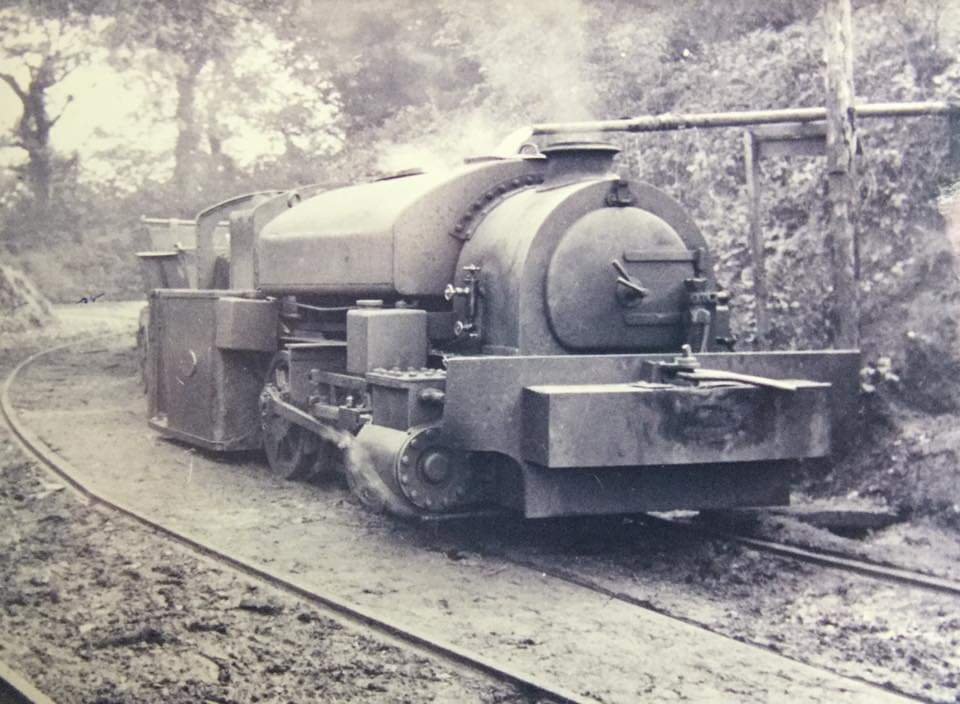




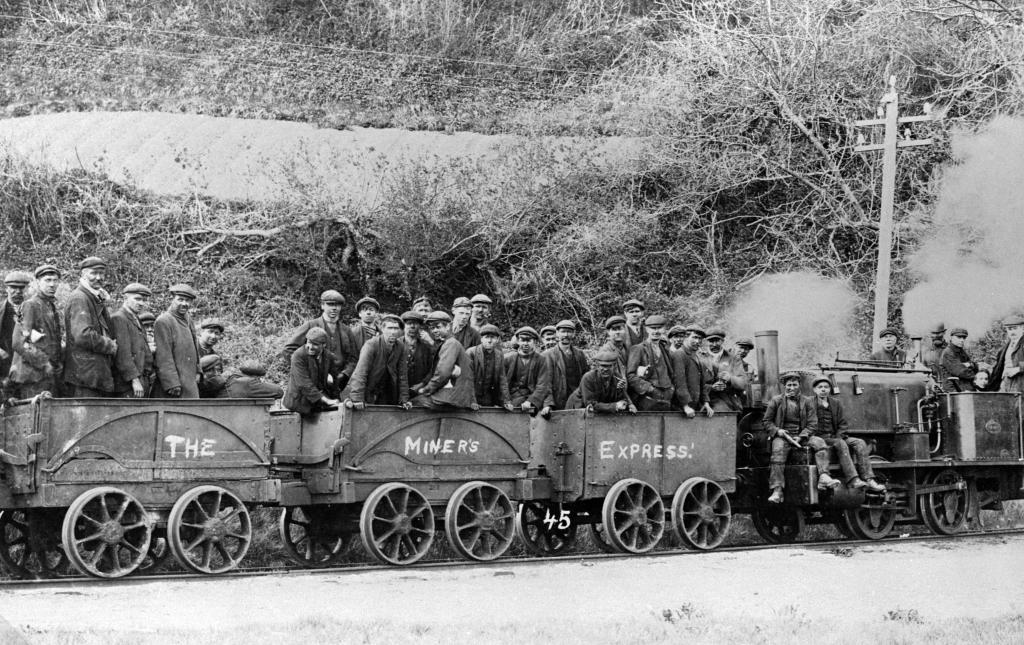
The Route of the Railway
We have already noted that there were two main lines which met at Saundersfoot Harbour. It seems to be a good idea to start at the harbour and to look at each line in turn. This article covers the line to Stepaside via Wiseman’s Bridge. A second article will cover the line which heads West from the Harbour.
Saudersfoot Harbour to Stepaside via Wiseman’s Bridge
We start this journey at Saudersfoot Harbour with two very early views of the harbour and its tramroad.







From the harbour we head out along what was Railway Street (now called ‘The Strand’). First we have a series of views of Railway Street and its railway from the late 19th century and the early 20th century.




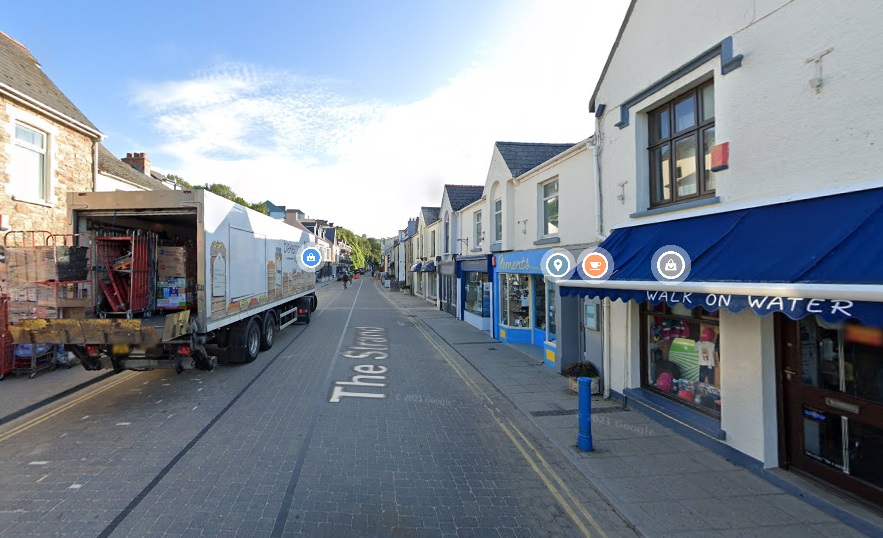


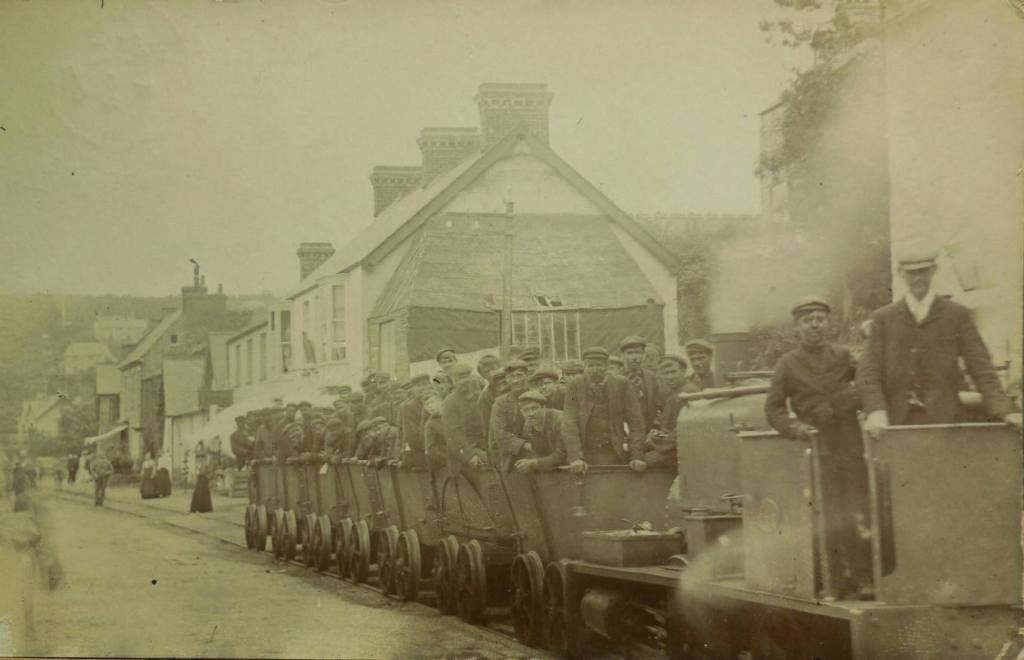

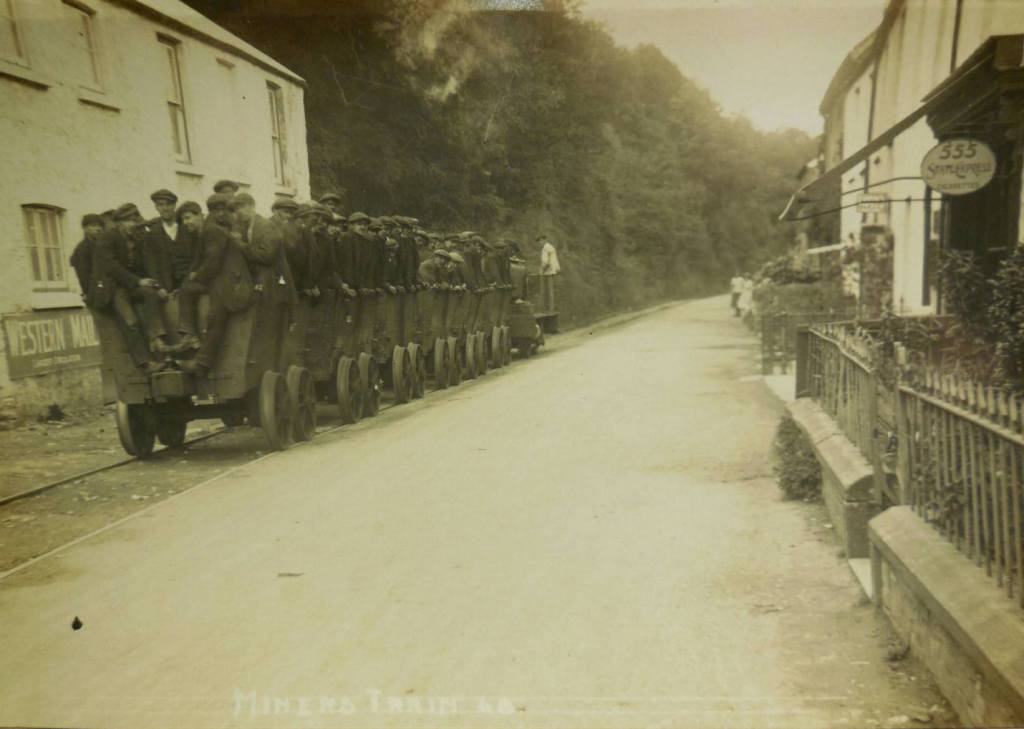


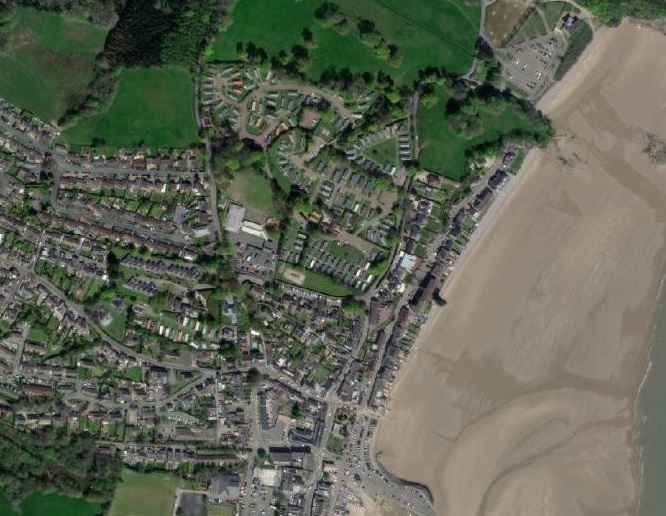




Before Saundersfoot Harbour’s development, coal was loaded into boats at Swallow Tree Bay (South of Saundersfoot) and Coppet Hall, (thought to derive from ‘coal pit haul’). [169]






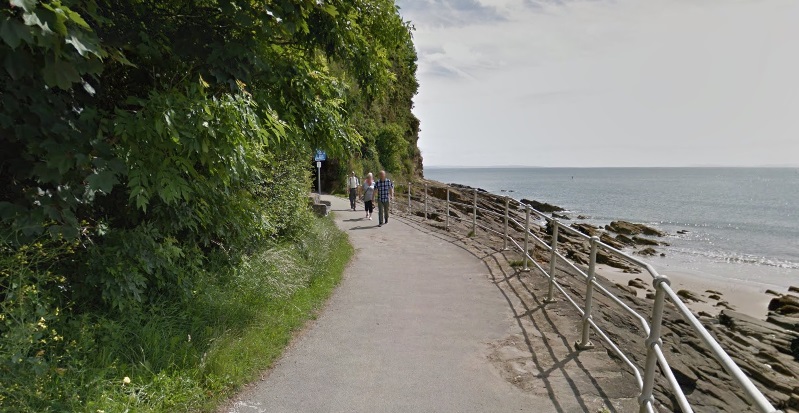





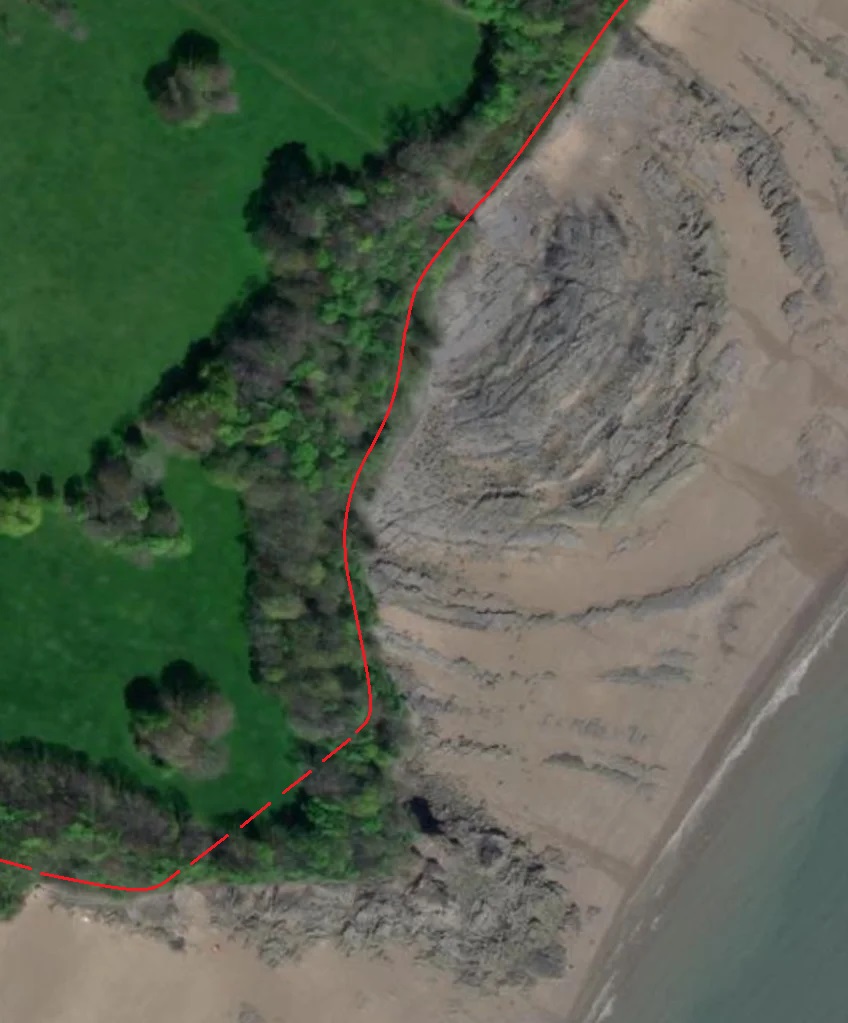



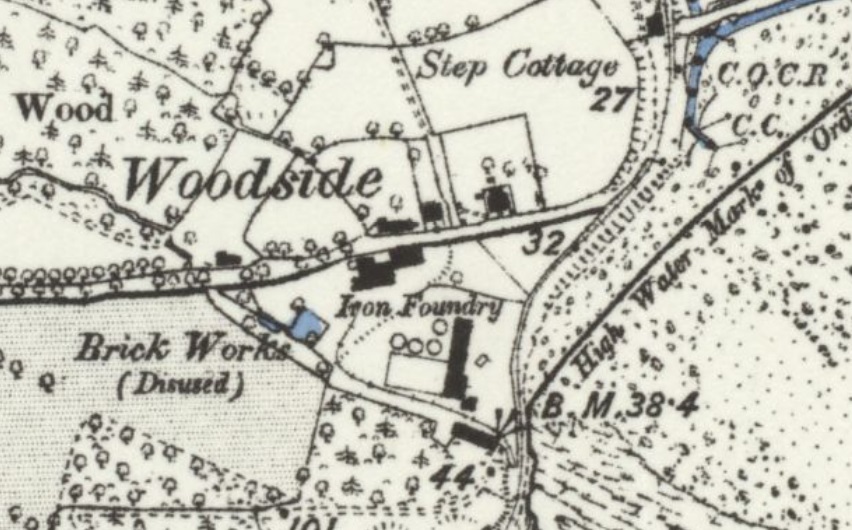





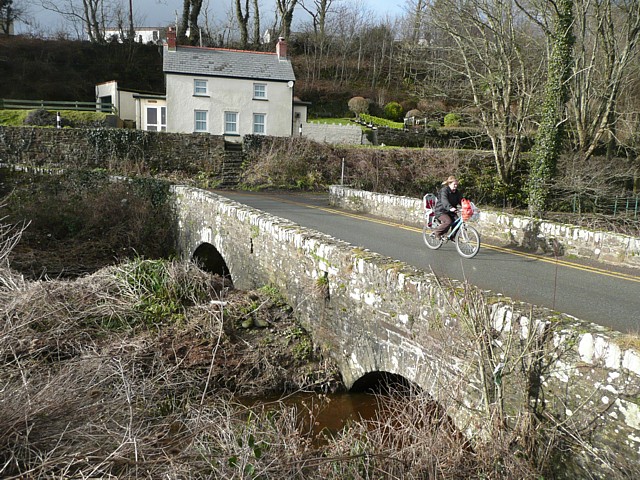
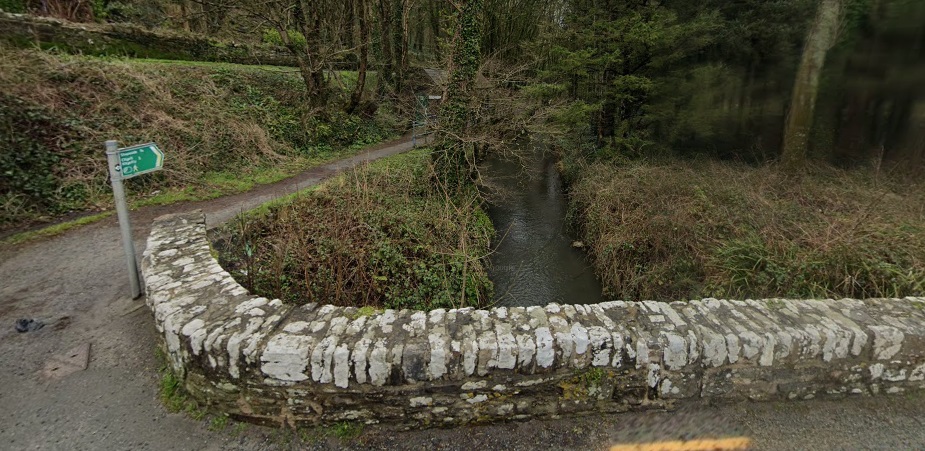


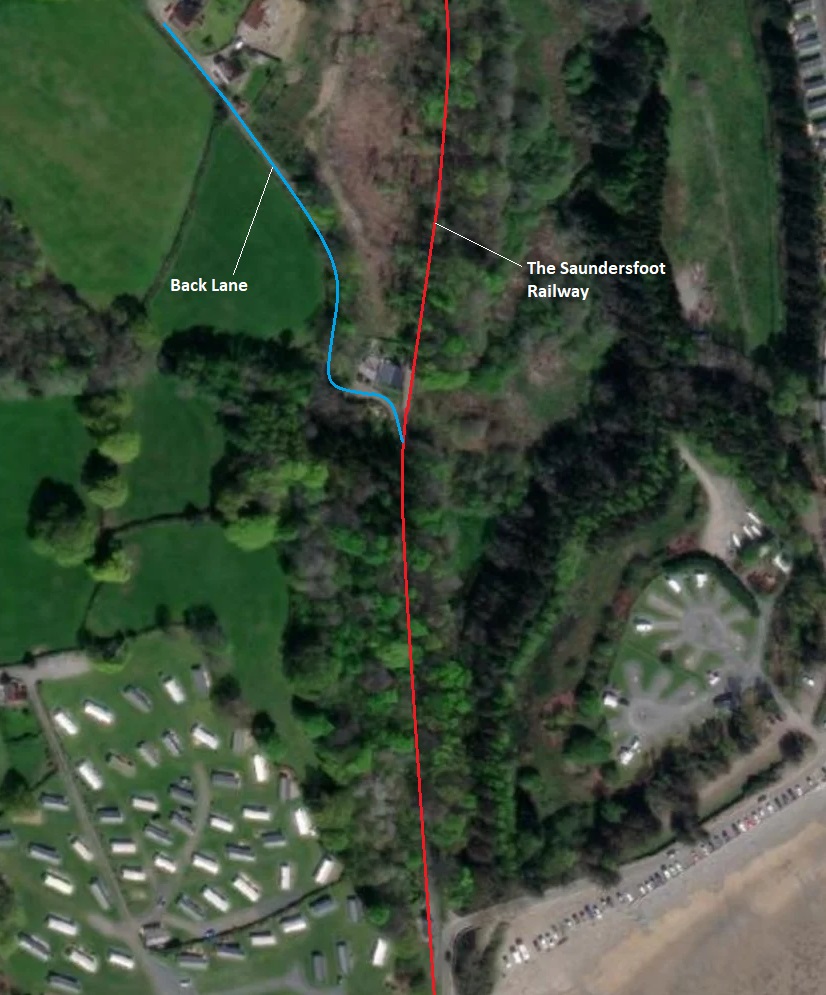







The satellite image above shows how significant the industry in the area of Stepaside was. Only a little remains. Amroth and District Community Association say that Stepaside was “a heavily industrialised site during the latter end of the nineteenth century with a thriving iron works using iron ore and limestone from local quarries. Today, this site is privately owned and features a chalet style complex. At one time, the village offered a school, post office, shop, garage and petrol station, a cobbler, a tailor and numerous public houses. Today, the only industry is the very busy coachworks, with several small housing estates.” [188]

The remains of Stepaside’s Ironworks are pictured above. Grove Colliery’s Engine House remains as a substantial ruin and is shown below.


Grove colliery had a deep shaft which extend 182 metres down into the ground and it’s workings extended over a large area as it followed the anthracite-bearing strata to extract the coal. The owners aim was to find the Kilgetty vein, which took until 1858, a period of some 5 years after opening and at a cost of £30,000. Eventually, the Grove Colliery was linked underground to the Kilgetty Colliery, a distance of some 795 metres.
Coal from the Grove Colliery was carried both on the Saundersfoot Railway via Stepaside and on a self-acting incline to the Ironworks in the valley below. The colliery had its own stables, stores, carpenter’s shop and smithy.
Lower Level Colliery, according to Coflein, appears on the early OS mapping (1887/1889) but on the second edition of 1906/1907 it is marked as disused, having closed in 1900. According to OS mapping of 2013, the site has been cleared and landscaped. [190]
Coflein also notes that Kilgetty Colliery was an anthracite colliery dating from around 1843. It closed in 1873 but was re-developed and re-opened in 1935, with a weighbridge house, ventilation drift and winding engine house. Another winding engine house (now converted) stood nearby. The colliery closed finally in 1939 by 2003 the site was largely built over. [191]
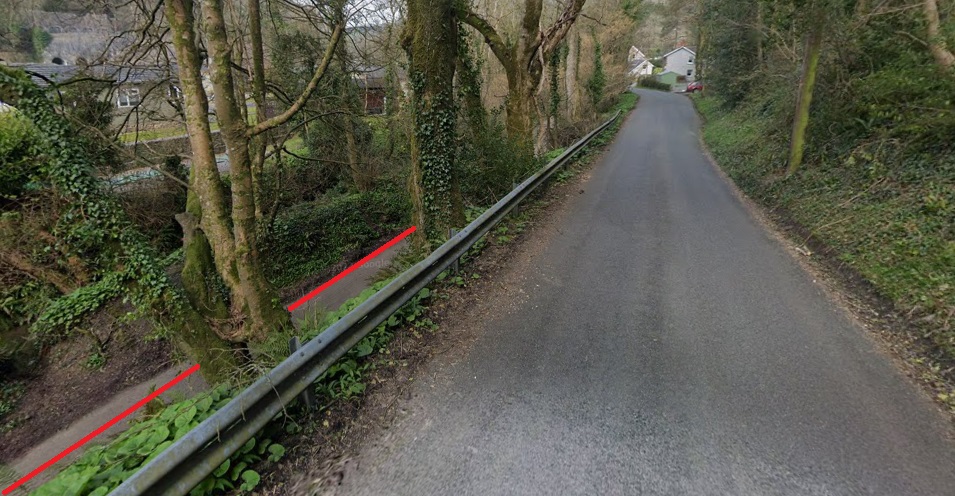









Before passing under the bridge we take a quick look back down the branch to Grove Colliery.

Beyond the housing visible in the picture above the railway crossed the old Kilgetty Canal before climbing the hill beyond. The tramway bridge now carries a footpath as shown on the OpenStreetmap extract below. British Listed Buildings website tells us that the bridge carried the “private branch of the tramway known as the Saundersfoot Railway to the high level of Kilgetty Ironworks of the Pembrokeshire Coal and Iron Company (which commenced production in 1849) and on to Grove Colliery of the same Company. As it is likely to have been one of the first things constructed, its date is probably c.1846. It probably remained in tramway use until the closure of the colliery in c.1900.” [196]
The bridge is a single-arch skew bridge of local sandstone, with an arch span of about 4 m. and a width of about 6 m. Low parapet on the SW side, restored, with modern railings.

On the other side of the bridge the old railway has another junction. The longer arm to the left heads for Lower Level Colliery. The route ahead served Kilgetty Colliery. I have not as yet been able to find photographs of these two collieries.


We noted above how the route of line to Lower Level Colliery crosses the line of the A477. The composite image below brings together the 6″ OS Map of 1906 and modern satellite imagery to show how close Lower Level Colliery was to the line of the new road.

This is the point at which we leave the arm of the Saundersfoot Railway which ran North from the Harbour.

References
1. M.R. Connop-Price; Pembrokeshire: the Forgotten Coalfield; Landmark Publishing, Ashbourne, Derbyshire, 2004
32. D S M Barrie, revised Peter Baughan; A Regional History of the Railways of Great Britain: volume 12: South Wales; David St John Thomas, Nairn, 1994.
36. Wing Commander Ken McKay; A Vision of Greatness: The History of Milford 1790-1990; Brace Harvatt Associates, 1989.
49. https://en.m.wikipedia.org/wiki/Saundersfoot_Railway, accessed on 12th September 2022.
130. https://www.saundersfootharbour.co.uk/media/1072/archaeology-final.pdf, accessed on 22nd September 2022.
131. https://maps.nls.uk/geo/explore/#zoom=17.0&lat=51.71103&lon=-4.69706&layers=6&b=1, accessed on 22nd September 2022.
132. http://www.saundersfoot.co.uk/history.htm, accessed on 22nd September 2022.
133. https://coflein.gov.uk/en/site/34611, accessed on 22nd September 2022.
134. The tramroad was built between 1839 and1834, [1: p131][49] the harbour, between 1829 and 1830. [133] Boneville Court Colliery was not established until 1842 [1: p132] and the Ironworks were established in 1848/1849. The Ironworks were active intermittently until 1868 when the complex was sold to Bonville’s Court Coal and Iron Company around 1873. The ironworks finally closed in 1877 and were dismantled in 1887-89. The chimney stack above the furnaces was eventually demolished in 1909. [135]
135. https://coflein.gov.uk/en/site/40500, accessed on 22nd September 2022.
136. M.R. Connop-Price; The Saundersfoot Railway; Oakwood Press No. 28, Usk, Monmouthshire, 1989. (1st Edition – 1964)
137. https://m.facebook.com/groups/trulypembrokeshire/permalink/1502181089825761, accessed on 22nd September 2022.
138. https://m.facebook.com/groups/trulypembrokeshire/permalink/1699232046787330, accessed on 22nd September 2022.
139. https://m.facebook.com/groups/trulypembrokeshire/permalink/5242141129163053, 22nd September 2022.
142. https://scontent-lcy1-1.xx.fbcdn.net/v/t1.6435-9/33192602_10160541939030387_2502462166733422592_n.jpg?_nc_cat=109&ccb=1-7&_nc_sid=825194&_nc_ohc=_kdkHT2bA3IAX_X5iPS&tn=DD78eVYNE2dp2pQo&_nc_ht=scontent-lcy1-1.xx&oh=00_AT-jLDNv-oPwp16tMe3Ni0-b0epw5s8fbBL6inedhfXnjA&oe=6351DC06, accessed on 23rd September 2022.
143. https://scontent-lcy1-1.xx.fbcdn.net/v/t1.6435-9/42194079_10155412717052030_3078165209496420352_n.jpg?_nc_cat=107&ccb=1-7&_nc_sid=825194&_nc_ohc=2-GJjTGuaw0AX9BzjBt&tn=DD78eVYNE2dp2pQo&_nc_ht=scontent-lcy1-1.xx&oh=00_AT-90aTbR3FgnT26wWoShBfEhMZvcNuD7YcA5nO2XbsvwA&oe=6354C985, accessed on 23rd September 2022.
144. These comments were made by Mike Roch and he indicates that he picked up the information from a book by M.R. Connop-Price, ‘Industrial Saundersfoot’. The comments are made alongside a series of photographs of the remailing lengths of the canal taken and shared by Mike Roch on 23rd November 2021 on the Saundersfoot & District Historical Society Facebook Group. The pictures can be found by following this link: https://www.facebook.com/groups/1806381086087895/search/?q=tramway, accessed on 23rd September 2022.
145. https://scontent-lcy1-1.xx.fbcdn.net/v/t31.18172-8/12273767_1181445278550058_2973686661313192780_o.jpg?_nc_cat=102&ccb=1-7&_nc_sid=825194&_nc_ohc=_DsTf3s9pT0AX_T9w9F&tn=DD78eVYNE2dp2pQo&_nc_ht=scontent-lcy1-1.xx&oh=00_AT89OSHBzP2E3NMlacOFtSiWMMXFjVSCzHGo52b-9p1J1A&oe=63520B59, accessed on 23rd September 2022.
146. https://scontent-lcy1-1.xx.fbcdn.net/v/t31.18172-8/12310045_1181444975216755_2190846757694600552_o.jpg?_nc_cat=104&ccb=1-7&_nc_sid=825194&_nc_ohc=G9kMXdTKoWgAX8z3P6W&_nc_ht=scontent-lcy1-1.xx&oh=00_AT-lyEfJUhKkj5RnqKR-A2bIYhwxuQ2dzNRDSYc7Upo00Q&oe=63522E61, accessed on 23rd September 2022.
147. https://scontent-lcy1-1.xx.fbcdn.net/v/t1.18169-9/15326342_1443586592328071_5779504489323789919_n.jpg?_nc_cat=104&ccb=1-7&_nc_sid=825194&_nc_ohc=Zp1WksEqFboAX9mCqr6&_nc_ht=scontent-lcy1-1.xx&oh=00_AT_7ARh0GE17QcdCfWFLRZPN_kjjgWj8JFIIAY7cLnxQZA&oe=63519F20, accessed on 23rd September 2022.
148. https://scontent-lcy1-1.xx.fbcdn.net/v/t31.18172-8/12239217_10153292740546220_1364977808131440036_o.jpg?_nc_cat=110&ccb=1-7&_nc_sid=b9115d&_nc_ohc=T1j6evBs-qUAX-qTyVf&_nc_ht=scontent-lcy1-1.xx&oh=00_AT99_FCh-C8qMzKvptVV7M45ErozbSBljfm6La4_WuxP-w&oe=6354DACD, accessed on 23rd September 2022.
149. https://scontent-lcy1-1.xx.fbcdn.net/v/t31.18172-8/12273566_10153292742741220_3372522987221543576_o.jpg?_nc_cat=109&ccb=1-7&_nc_sid=b9115d&_nc_ohc=BfrTe4xLapUAX_gYxTa&tn=DD78eVYNE2dp2pQo&_nc_ht=scontent-lcy1-1.xx&oh=00_AT8c8qdgDbiL9k_UCHgY_nnEjJdXx1HZP6y37qmXa2fiuA&oe=63550C6E, accessed on 23rd September 2022.
150. https://scontent-lcy1-1.xx.fbcdn.net/v/t31.18172-8/12265914_10153292740711220_9126860851101626552_o.jpg?_nc_cat=101&ccb=1-7&_nc_sid=b9115d&_nc_ohc=OQ15LjgCidwAX8DgcVt&_nc_ht=scontent-lcy1-1.xx&oh=00_AT-iftDOC73X6omdyQ-exYxLPT2_tzcSbNwELAPiR-6ZHA&oe=63546259, accessed on 23rd September 2022.
152. https://museum.wales/collections/online/object/072b5cb6-0d20-3629-9d64-8d5602809df1/The-Miners-Express-Saundersfoot-Railway-postcad, accessed on 23rd September 2022.
153. https://museum.wales/media-dams/96e01d8b-9ef5-3165-b52f-45de6945417f/large, accessed on 23rd September 2022.
154. https://museum.wales/collections/online/object/8f29aec0-6e28-33d5-872d-70d3fba99e2d/Saundersfoot-Railway-Street-postcard, accessed on 23rd September 2022.
155. https://encrypted-tbn0.gstatic.com/images?q=tbn:ANd9GcTNAC-VixIAyJNINfQXjZCxWQ0GwyV0Nl05LI50q–kTw&s, accessed on 23rd September 2022.
157. https://www.facebook.com/photo/?fbid=10151224115811220&set=gm.2076025112536745&idorvanity=2075834939222429, accessed on 23rd September 2021.
158. https://www.facebook.com/photo/?fbid=1300990836642576&set=pcb.2667192270086690, and https://www.facebook.com/photo?fbid=1300991336642526&set=pcb.2667192270086690, accessed on 23rd September 2022.
159. https://www.facebook.com/photo/?fbid=2929529600408275&set=gm.3279183382220906, accessed on 23rd September 2022.
160. https://www.facebook.com/photo/?fbid=2463892470564492&set=pcb.3238312006308044, accessed on 23rd September 2022.
161. https://www.facebook.com/photo?fbid=2724987104455026&set=pcb.3509864795819429, accessed on 23rd September 2022.
168. https://maps.nls.uk/geo/explore/#zoom=16.0&lat=51.71408&lon=-4.69845&layers=6&b=1, accessed on 23rd September 2022.
169. https://good-trails.com/2016/07/20/coal-mining-saundersfoot, accessed on 23rd September 2022.
170. https://maps.nls.uk/geo/explore/#zoom=18.0&lat=51.71624&lon=-4.69399&layers=6&b=1, accessed on 24th September 2022.
171. https://maps.nls.uk/geo/explore/#zoom=17.0&lat=51.71871&lon=-4.68954&layers=6&b=1, accessed on 24th September 2022.
172. https://maps.nls.uk/geo/explore/#zoom=17.0&lat=51.72196&lon=-4.68729&layers=6&b=1, accessed on 24th September 2022.
173. https://coflein.gov.uk/en/site/524997, accessed on 24th September 2022.
174. https://coflein.gov.uk/en/site/419986, accessed on 24th September 2022.
175. https://maps.nls.uk/view/102188916, accessed on 24th September 2022.
176. https://commons.wikimedia.org/wiki/File:Wiseman%27s_Bridge_-geograph.org.uk-_1692079.jpg, accessed on 24th September 2022.
177. https://maps.nls.uk/geo/explore/#zoom=17.0&lat=51.72486&lon=-4.68735&layers=6&b=1, accessed on 24th September 2022.
178. https://maps.nls.uk/geo/explore/#zoom=16.0&lat=51.72950&lon=-4.68747&layers=6&b=1, accessed on 24th September 2022.
179. https://m.facebook.com/groups/2075834939222429/permalink/2488370781302174/, accessed on 25th September 2022.
180. https://www.facebook.com/groups/saundersfootdistricthistorialsoc/permalink/2161261967266470, accessed on 25th September 2022.
181. https://museum.wales/collections/online/object/0a0dad7c-06d6-3d40-8eb0-88b2777f3350/Coal-Staithes-at-Saundersfoot-Harbour-postcard, accessed on 25th September 2022.
182. https://www.peoplescollection.wales/items/381602, accessed on 25th September 2022.
183. https://commons.wikimedia.org/wiki/File:Information_board_about_the_Saundersfoot_Railway_-geograph.org.uk-_1875332.jpg, accessed on 25th September 3022.
185. https://maps.nls.uk/geo/explore/#zoom=16.0&lat=51.73566&lon=-4.69900&layers=6&b=1, accessed on 25th September 2022.
186. https://maps.nls.uk/view/102188916, accessed on 25th September 2022.
187. I found this image while searching on Facebook and cannot now find the dull link back to it. This is the record of the image that I kept … facebook_1664055146584_6979553157540841155.jpg … if anyone is better at following these things through on Facebook, please feel free to do so.
188. https://amrothparish.co.uk/stepaside, accessed on 25th September 2022.
189. https://commons.wikimedia.org/wiki/File:Grove_Colliery,Stepaside–geograph.org.uk-_876333.jpg, accessed on 25th September 2022.
190. https://coflein.gov.uk/cy/safle/308435, accessed on 25th September 2022.
191. https://coflein.gov.uk/cy/safle/308436, accessed on 25th September 2022.
192. https://coflein.gov.uk/en/site/43051/images, accessed on 25th September 2022.
193. https://m.facebook.com/groups/1844080002283442/permalink/1847420908616018, 25th September 2022.
194. https://m.facebook.com/groups/1844080002283442/permalink/1847421388615970, accessed on 25th September 2022.
195. https://www.geograph.org.uk/photo/1641912, accessed on 26th September 2022.
196. https://britishlistedbuildings.co.uk/300018861-tramway-bridge-amroth#.YzFlhnbMKUm, accessed on 26th September 2022.
197. https://www.facebook.com/groups/2075834939222429/permalink/3499066880232554, accessed on 26th September 2022.
198. https://www.facebook.com/photo/?fbid=10220671462327862&set=pcb.3482746961864546, accessed on 26th September 2022.


Pingback: Railways in West Wales Part 1C – Pembrokeshire Industrial Railways – Section B – The Saundersfoot Railway (Second Part) | Roger Farnworth
Pingback: Railways in West Wales Part 1C – Pembrokeshire Industrial Railways – Section C – RNAD Trecwn | Roger Farnworth